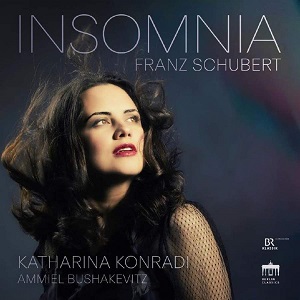
Franz Schubert (1797-1828)
Insomnia
Katharina Konradi (soprano)
Ammiel Bushakevitz (piano and guitar)
rec. 2022, Bayerischer Rundfunk Studio 2, Munich.
No texts enclosed.
Reviewed as download from press preview.
Berlin Classics 0302961BC [71]
Katharina Konradi first came to my notice four years ago when I reviewed Mayr’s I Cherusci (review), and since then she has appeared in several recordings, including a couple of recitals, which I unfortunately haven’t heard. Since I admired her contribution to the Mayr opera, I was keen to hear her again, and this Schubert disc fulfilled my expectations. Insomnia encompasses many aspects of life and the night has always had a special attraction for poets, painters and musicians. Schubert was no exception, and his more than 600 songs are a rich source to scoop from. Konradi and Ammiel Bushakevitz have wisely looked beyond the more self-evident pieces and included more than half a dozen relative rarities. Another interesting feature is that more than a third of the songs are accompanied by guitar. Bushakevitz studied classical guitar for more than fifteen years, and it was a pleasure for him to return to the instrument for this recording. He also made the arrangements in keys that suited Katharina. It is interesting that “Schubert never owned a piano but had access to guitars and probably owned one or two”, says Ammiel in the notes to this recording. Several of his friends played guitar, which was in vogue in the 1820s, and no fewer than 26 of his songs were published with guitar accompaniment during this period. The man behind this was Diabelli, who also played the guitar. The weaker sounds of the guitar naturally invite a more intimate approach, the antithesis to some of the powerful and dramatic songs – for instance the last two pieces of the programme, Der Zwerg and Nacht und Träume. A highlight is Der Vollmond strahlt, from the incidental music to Rosamunde; another well-known song that gains from the intimacy of the guitar is Ständchen from Schwanengesang. It has almost achieved the status of a folksong, and in this version that sense is reinforced.
Katharina Konradi’s beautiful lyric soprano voice is well suited to performing with guitar. When asked the difference between singing with piano and guitar, she answers in the notes: “With the guitar I had to set my voice at a new level, find a more intimate, lighter and maybe more relaxed tone. Because when I sing to the guitar, my bodily tension is different. I feel myself closer to my accompanist, almost as if we had a tacit agreement that we were making music just for ourselves. The great challenge then is to draw the audience into this intimacy and make them part of something almost secret.” And that is the impression one gets when listening. I can imagine the two musicians sitting close together and close to the listener. This is the epitome of intimacy.
But they also achieve intimacy in the piano-accompanied songs, although the letters are a size bigger. The rapport between singer and pianist feels very close – like twin souls. I know that behind an achievement like this there is a lot of hard work, but the important thing is that the listener experiences spontaneity. Beautiful tone is an important part of Lieder singing, but just as important – even more perhaps – is the ability to convey the text to the listener, to interpret the poet’s message and make the words come alive. There is feeling in Katharina Konradi’s phrases and delicate nuances – and when required she has the heft to carry over the drama, without over-taxing the lyrical voice. She is, operatically speaking, a Sophie not a Feldmarschallin.
Browsing through the playlist, I suspect that many readers will detect titles they don’t recognise. But fear not! They are out of Schubert’s top drawer, all of them. Try the first one, describing the setting sun. It is as melodiously attractive as any other lied by Schubert – and Katharina Konradi obviously loves it, singing with warmth, feeling and beautiful tone. The same can be said about Berthas Lied in der Nacht, a song that at present is available in about ten recordings, compared to innumerable versions of Die Forelle. In other words, we are in for both a gentle trip down memory lane and an expedition into some obscure backyards – and our guides are the best imaginable. Happy journey!
But wait! There is a fly in the ointment: there are no song-texts enclosed, so it is up to you to decide whether or not you need a map.
Göran Forsling
Help us financially by purchasing from


Contents
1 An die untergehende Sonne, D.457 5:32
2 Im Abendrot, D.799
(arranged for guitar accompaniment)* 3:25
3 An mein Herz, D.860 3:06
4 Berthas Lied in der Nacht, D.653 4:01
5 Die Nacht, WoO
(arranged for guitar accompaniment)* 3:51
6 Die Sterne, D.939 3:30
7 Ständchen (Leise flehen meine Lieder), D.957
(arranged for guitar accompaniment)* 3:49
8 An den Mond, D.296 4:48
9 Der Geistertanz, D.116 1:58
10 Des Fischers Liebesglück, D.933
(arranged for guitar accompaniment)* 8:24
11 Lied der Anne Lyle, D.830 3:27
12 An die Nachtigall, D.196 1:59
13 Meeres Stille, D.216
(arranged for guitar accompaniment)* 1:53
14 Der zürnenden Diana, D.707 5:23
15 Gesang der Norna, D.831 3:28
16 Romanze, from “Rosamunde“, Op. 26, No. 1, D.797
(arranged for guitar accompaniment)* 3:23
17 Der Zwerg, D.771 5:38
18 Nacht und Träume, D.827
(arranged for guitar accompaniment)* 3:19


















